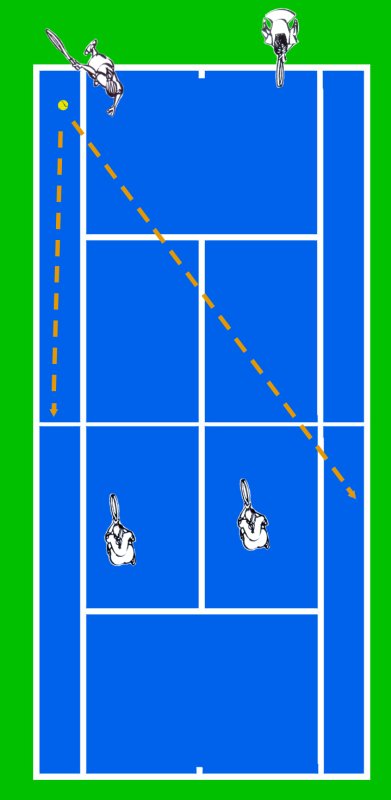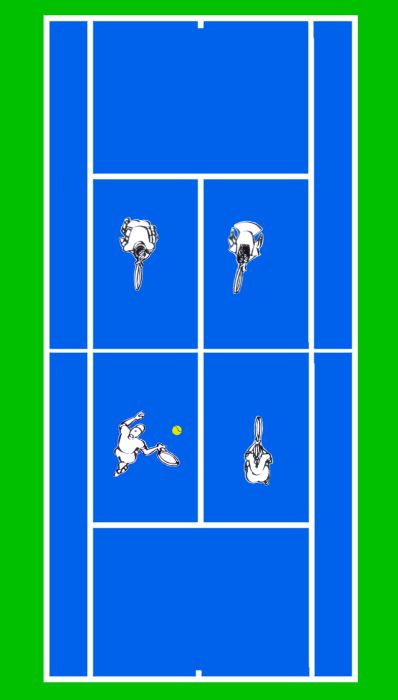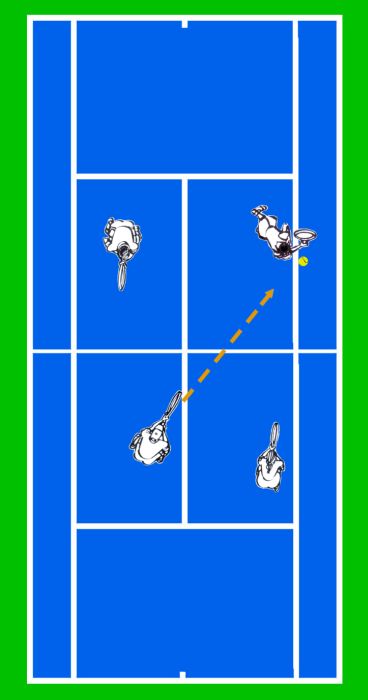| Tennis Home |
| Introduction |
| 1 - The Basic Stroke |
| 2 - Proper Court Position |
| 3 - Defensive Strategy |
| 4 - Offensive Strategy |
| 5 - Serve and Return |
| 6 - Situation Tennis |
| Racquets and Stringing |
|
Tennis for Seniors Author- Richard M. Berger 09/15/2010 All rights reserved You are able to view this book because the author has given you a user name and password to gain access. Please do not copy the book or give your password to others. If you think you know someone who could benefit from this book, please send me their name and e-mail address and I will see that they get a password of their own. My e-mail is: tennis@bergerweb.net Have Fun, and enjoy tennis, the sport for a lifetime. |
|
Defensive Strategy Covering the Possibilities |
In chapter 2 we described the ideal controlling position for doubles as having both players forward, side by side, each about equal distance from the singles sideline and the center stripe, and about two steps inside the service line. In the past, most tennis instructors have taught that the best doubles formation is one player at about the center of each service box. This attitude has changed in recent years. With the advent of newer, high-tech racquets, the pace of the ball has become greater, forcing players to play back a little further to give them time to react to their opponents shots. It's important for older players to take this into account. Sure, senior opponents can't strike the ball as hard as the younger players, but good senior players compensate by stringing their racquets for more power, and placing their shots more accurately. In addition, our reflexes aren't as fast so we need the extra reaction time. Also remember that this is not a fast rule.
 If you and your partner both have lightening-quick reflexes, by all means, consider getting a little closer to the net. You will be able to hit sharper angled volleys, yet still be able to handle most lobs. But don't be foolish enough to try to play from a position which you can't handle.
If you and your partner both have lightening-quick reflexes, by all means, consider getting a little closer to the net. You will be able to hit sharper angled volleys, yet still be able to handle most lobs. But don't be foolish enough to try to play from a position which you can't handle.
From our ideal controlling position, we can defend the biggest area, as long as our shot to the opponents has been placed down the center of the court. But the situation changes when the ball is in a different position. What do you do when your opponent is about to strike a ball that is in the left hand corner of the court, as shown in the illustration to the right? As you can see, the players have moved over to their left so that they still form a curtain that protects the largest possible area of their side of the court. The player to the left has moved half a step toward the left sideline, and the player to the right has moved left and forward slightly. Together they have forced the opponent to either lob, or try to place the ball down the line or sharply cross-court. As long as the two forward players keep their shots deep, they will need only to shift their positions slightly left or right to form a curtain against their opponents possiblilties. In effect, they are forcing a lob, and hoping to pick it up with a winning overhead.
A different situation exists when all four players are inside the service line, at or near the controlling position. This is where the most exciting doubles play takes place. I remember a Wimbledon Match in which Cathy Jordan and Elizabeth Smiley were playing against Martina Navratalova and Pam Shriver. Martina served to Cathy in the ad court. The return landed at the feet of Navratalova, who was rushing toward the net. When she split-stepped, she lost her footing, falling backwards, but still half-volleying the ball back down the line past Liz. Cathy covered behind Liz and drove the ball down the line. Martina, having recovered to her feet, volleyed the shot down the middle, but by then, Liz had switched sides, and had that shot covered. She hit a hard ground stroke right at Martina, but it clipped the top of the net. Martina's reactions were fast enough to stab a volley back at Liz' feet, and Liz' low volley went over the baseline. The action was so fast that without instant replay, the cameras couldn't keep up with what was happening.
This kind of play happens all the time when advanced players get in to volleying position. When you are in these situations, you don't have time to think. You must instinctively react to every shot so that you can cover the possible shots that your opponents may hit.
 The best doubles instructor I ever had gave me the best advise I ever heard, all contained in these two items
The best doubles instructor I ever had gave me the best advise I ever heard, all contained in these two items
1. Move laterally with the ball.
2. Be super-ready.
Each time you or your partner sends the ball over the net, you must judge which opponent will hit it back, and from where it will come. In the diagram to the left, notice that the ball is slightly to the left of the center line, and one of the team in the lower court is about to strike it. The team on the top court has moved slightly to their right so that they can cover their right sidline, the center, and most of their left court. They have formed a curtain to protect the largest possible area of their court. They also know that most experienced teams will volley a ball near the center back to the center of the opponent's court. [You will see more about this in the next chapter.]
 The diagram at the right shows what should happen when you or your partner hits a ball into an opponent's alley The two players in the lower court have moved to their right to be able to cover the down-the-line attempt by their opponent. The player on the right has also moved back slightly to give herself space to react. The player on the left has moved right, but he has moved slightly forward. He can afford the more aggressive position because given the space between him and the ball, he still has time to react to the diagonal shot that would come toward him. He must be careful, though, because any lob by the opponent will probably go over his head, and he will be the one most able to retrieve it. Ideally, the defensive team will defend most of the court, but some court will be left unprotected. They should divide the unprotected area into three very small areas, one to their left, one to their right, and a tiny sliver down the middle. The idea is to tempt the opponents to try the two riskiest shots... the ones on the outside. Note that the two players in the lower court have again formed a curtain to protect against the most likely shots that their opponent can take.
The diagram at the right shows what should happen when you or your partner hits a ball into an opponent's alley The two players in the lower court have moved to their right to be able to cover the down-the-line attempt by their opponent. The player on the right has also moved back slightly to give herself space to react. The player on the left has moved right, but he has moved slightly forward. He can afford the more aggressive position because given the space between him and the ball, he still has time to react to the diagonal shot that would come toward him. He must be careful, though, because any lob by the opponent will probably go over his head, and he will be the one most able to retrieve it. Ideally, the defensive team will defend most of the court, but some court will be left unprotected. They should divide the unprotected area into three very small areas, one to their left, one to their right, and a tiny sliver down the middle. The idea is to tempt the opponents to try the two riskiest shots... the ones on the outside. Note that the two players in the lower court have again formed a curtain to protect against the most likely shots that their opponent can take.
Wherever the ball is on your opponent's side of the net, you and your partner must, as a team, mirror that position on your side of the court. Your team will then be in position to cut off almost any down-the-line or cross-court drives. Remember that the most common mistake is to guard the down-the-line alley too vigorously, leaving too much space between you and your partner, so that the opponent has an opening down the middle. There is never a situation where you can cover all possible shots that your opponent can take. Your job is to force him to take the more difficult shots. Don't leave the middle of the court open.... that's the safest shot he has. Make him instead go for the sliver of space between you and the sideline.
An important thing to remember when talking about defense is that even though one member of your team is about to strike the ball, the other team member is still responsible for defending a portion of the court. For example, during a cross-court rally between two deep players, with the other two players at net, when the deep player is about to hit the ball, his partner must position himself a little back and toward the center of the court. Why? Because should the opposing net player be able to cut off the ball, he would have a wide open shot between the two players if the net man did nothing to protect the shot aimed at the center of the court. By moving back and toward the center of the court, the net person minimizes that risk. He should not move forward again until his partner's shot has passed safely by the opposing net person.
Defending against the Lob Queens
You haven't had a real challenge until you run up against a doubles team who can both lob well. When a match is sliding away from you because you are being lobbed to death, you have two choices. You can give up, saying "This isn't tennis. I'd rather just quit and go play golf.", or you can dig in and be patient. The match may last 2 hours, but take heart in knowing that your opponents have respect for your volleying capabilities.
The key to success against a lobbing team is taking the ball out of the air, rather than allowing it to bounce. This requires skill in watching your opponent's racquet so you can predict when the lob is coming, and good footwork and movement on the part of both partners. When you are both in the ideal controlling position, and both your opponents are at the baseline, focus on your opponents to get that tiny bit of a jump so you can position yourself for either a volley, if they drive the ball, or an overhead, if they lob the ball. You must also have the skill to hit forcing shots when the opportunity arises to hit an overhead.
Should both players go back when the opponent lobs? Not necessarily. When you recognize that the opponent is putting up a lob, both of you must react and begin to move back. If the lob goes over your head, and you must yell "Yours!" to your partner, you are not relieved of your duty. Your partner has to play the ball, so you must hustle across and defend the rest of the court. But when it becomes evident that one of you can take the ball out of the air, the other must move back toward the net and be ready to protect against a drive by the opponents. As you can see, the partner not hitting the ball is just as important as the one who does.
The options aren't quite so clear when you must chase down a lob that will bounce. Now you or your partner will be hitting a ball from well behind the baseline. If your opponents are alert, they will take advantage of that situation and advance toward the net. In that case, both you and your partner will have to take up defensive positions at the baseline. If, however, your opponents failed to move in on thier excellent lob, one of you can move back into the ideal controlling position and be ready for the next shot from your opponent. The main thing to remember is that both partners must initially consider the ball theirs, and react accordingly. Once it is obvious who will take the shot, the other partner proceeds to take up a defensive position.
There will be times when you must deal with a team that continually lobs the ball, and are good at keeping their lobs very deep. These teams generally camp on the baseline, and thrive on long points. To contend with this, both you and your partner may have to take up positions just inside the baseline. Then if the opposing team continues to lob, you will be ready to step forward and take the ball out of the air, rather than have it bounce. This gives you a big advantage, since you will then be hitting overheads from well inside the baseline where you can angle the ball off the court and make your opponents run. If they decide to drive the ball, you are still in a good position to step back and hit ground strokes. Remember, though, that to take advantage of a lob, you must take it before it bounces. Letting the ball bounce usually means you are striking the ball far behind the baseline, which gives your opponent lots of time to run down even your sharpest angle shots. When you take the ball out of the air, you are much closer to the net. You can hit greater angles, and the opponent has much less time to react.
There is one more thing that I like to keep reminding seniors to do. Split step every time your opponent strikes the ball. Seniors in particular have a tendency to just watch cross-court rallys between an opponent and their partner. This is a big mistake. Your mindset should be "the next ball is mine!" If you take this attitude, and you split-step each time either opponent strikes the ball, you will not miss those opportunities to cut off balls that can be your winners. You will be able to take lobs out of the air instead of saying "yours" and depending on your partner to run down those lobs. You also won't be off guard when an errant ball comes your way.